The Microsoft Surface Book 3 (15-Inch) Review: A Refreshing Dip Into Ice Lake
by Brett Howse on June 3, 2020 9:00 AM ESTDisplay
Microsoft committed to display quality in a big way back with the launch of the original Surface Book in 2015, and have continued to deliver some of the best displays in the PC industry. The Surface Book 3 offers the same display choices as the previous generation, with the 13.5-inch getting a 3000x2000 panel, and the 15-inch offering a 3240x2160 panel. The Surface Book team has also shown the importance of not only strong color accuracy and high resolution, but also high contrast ratios as well.
When Microsoft bucked the trend of 16:9 displays on Windows-based laptops, it was a big improvement to the tablet experience, since a 16:9 device works very poorly as a handheld display. The tablet capabilities have been promoted less over the years, but the 3:2 aspect they chose also tends to work very well for productivity tasks on a laptop computer. The industry took note, and we have all benefited, and more and more devices are shipping with taller aspect ratios, whether it be 3:2, or 16:10.
The one area where the 3:2 aspect can be a problem though is gaming, with some games counting on 16:9 aspect ratios. Thanks to the nearly seven million pixels on this panel, gaming at the native resolution, even with the GTX 1660 Ti, is not always possible, so having to fall back to 1920x1080 can be a hit or miss proposition. It can also cause some letterboxing when watching 16:9 video, but unless that is all you are planning on doing on the Surface Book, it likely won’t be an issue.
The seven million pixels translates into 260 pixels per inch, making the display much sharper than the Surface Laptop 3 15 (which is right at 200 pixels per inch), so text is very crisp.
Microsoft continues to include both an sRGB color mode, adhering very strictly to the sRGB gamut, as well as an “Enhanced” display mode, which adds a bit more punch to the colors. The only device Microsoft currently offers a wider-than-sRGB gamut is the Surface Studio desktop, which offers not only sRGB but also DCI-P3 and P3-D65 gamut options.
This is a bit of a touchy subject on Windows-based PCs though. Other manufacturers are adding wider gamut support such as P3-D65 or Adobe RGB, as well as HDR capabilities, so it may seem like a negative to not see this on Microsoft’s flagship notebook, but the fact of the matter is that the experience of using wide gamuts and HDR in Windows 10 is poor, to say the least. Windows has never offered a system-wide color management system, instead leaving the use of CMS up to individual applications, which as you can likely guess, more often than not do not leverage it. The Windows Shell itself has no color management built-in, so running a wide-gamut display will alter the colors of the desktop, Start Menu, and more. Until Windows fixes the mess that is color, it is probably the correct decision to stick with the “normal” gamut of sRGB even on a notebook such as this.
But, if there is to be any movement here, it feels like Microsoft is finally set up for success. In February, Panos Panay, who was the head of the Surface team, was tasked with heading the new Windows and Device team at Microsoft, so he is charge of not only Surface but also Windows Client. The Surface team has already brought about change in Windows, adding features that the Surface team required for their products directly into Windows, so if there was ever a time to see Microsoft take color management seriously, it would be now.
To see how the Surface Book 3 compares to its predecessors, we tested the display properties with an X-Rite i1Display Pro colorimeter for brightness and contrast measurements, and the X-Rite i1Pro2 spectrophotometer for color accuracy readings. As always, we thank Portrait Displays for the CalMAN software suite.
Brightness and Contrast
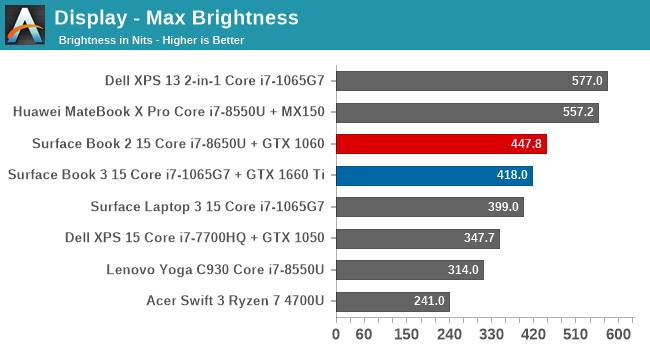
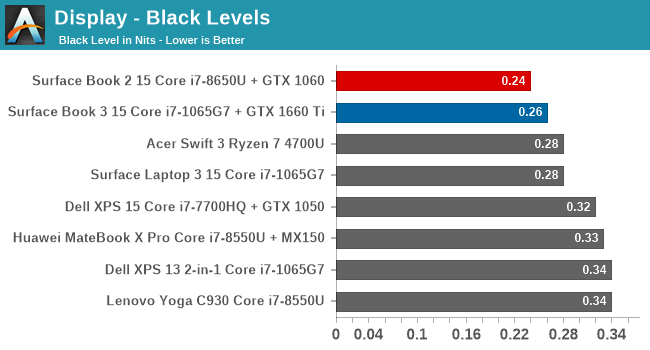
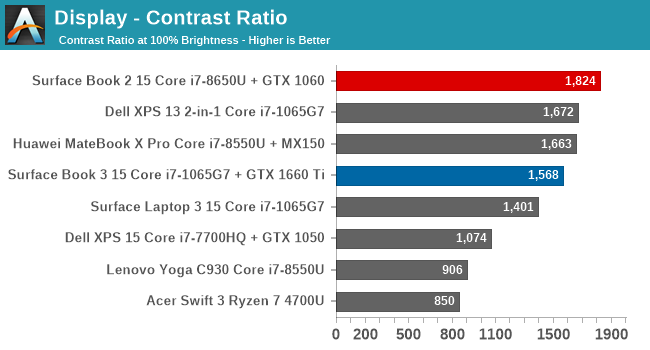
Despite the high-resolution panel, the Surface Book 3 achieves a solid 420 nits of brightness, and continues to offer the strong black levels we are accustomed to on this series of notebooks. It does not quite match the exceptional panel we had tested on the Surface Book 2, but it is still strong.
Grayscale
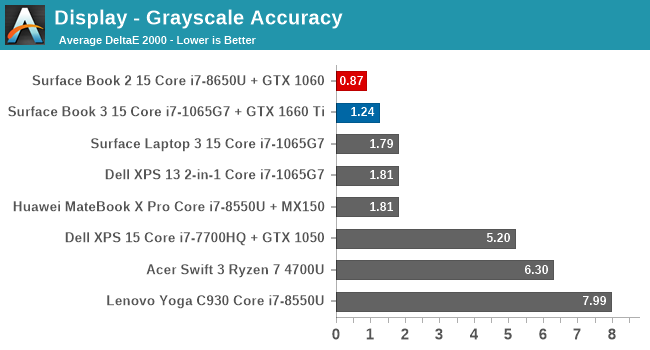
As usual, the Surface team’s calibration has done an excellent job, with very consistent RGB levels across the entire range, and error levels well under the 3.0 target. Gamma is slightly low at the dark end of the range, but manages to come in very close to the 2.2 target.
Gamut
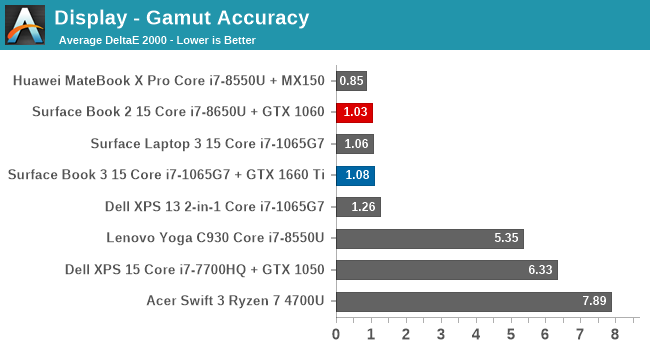
The Surface Book 3 achieves nearly perfect sRGB gamut coverage, with the blue levels only slightly off.
Saturation
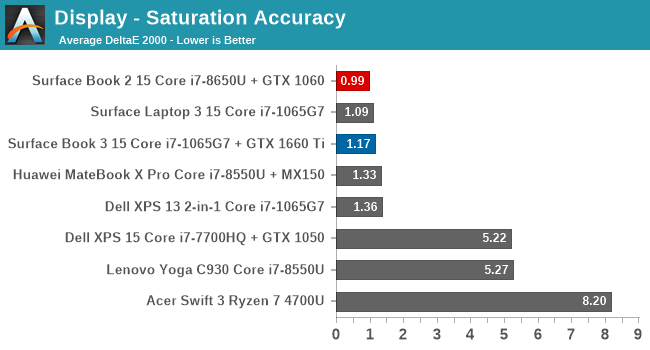
The saturation sweep tests the same primary and secondary color axis, but at 4-bit steps rather than at the 100% levels, and the Surface Book 3 delivers very strong results across the entire range. Red and Cyan are slightly off, but it would be difficult to detect with the naked eye.
Gretag Macbeth
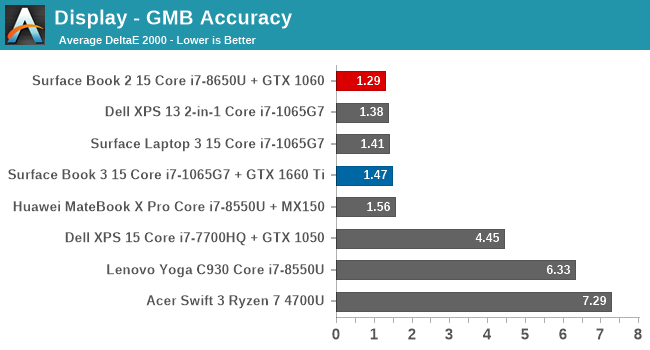
Our final test is the Gretag Macbeth, which not only tests the primary and secondary colors, but also many colors in-between, including the all-important skin tones. With an average error level of 1.46, the Surface Book 3 performs very well, and it achieves that without a single color having an error level above 3.0.
ColorChecker
Finally, this relative ColorChecker test shows the expected color on the bottom, and the achieved color on the top of the image. It is relative though because any error in your own monitor would be displayed here. But as we are used to on Surface devices, the display accuracy is fantastic.
Display conclusion
The Surface Book 3 continues to deliver one of the best display experiences in the PC space. The combination of high pixels-per-inch, strong contrast, and top-tier color accuracy continue to place the Surface Book 3 ahead of most displays on the market.
The lack of wider-gamut and HDR support is noticeable though on a spec sheet, even if the overall customer experience may not be as good as a proper sRGB display. We can hope that with Surface and Windows under the same leadership now, this may finally be addressed, but as we’ve seen with the High DPI changes in Windows 10, that change is not always easy or pain-free.



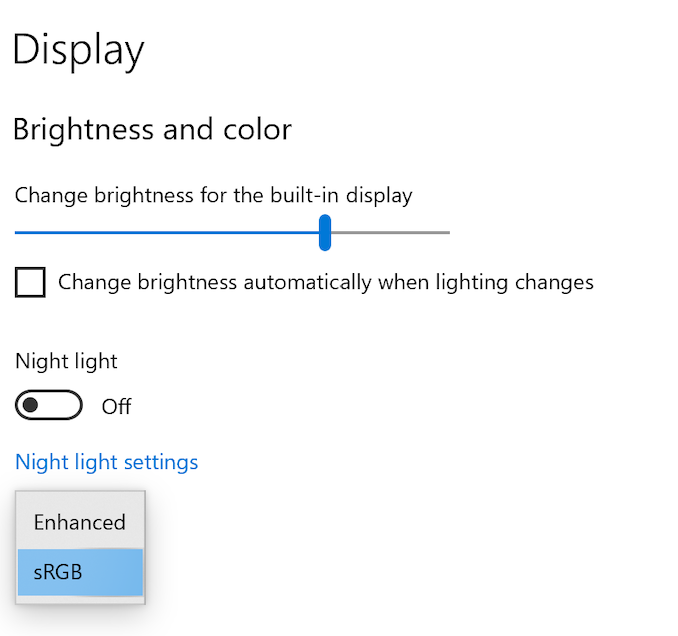













125 Comments
View All Comments
Icehawk - Wednesday, June 3, 2020 - link
And don’t forget if they drain the battery you can’t plug them into a dock to turn it on, you need to use a standalone charger to get it up to 10% or so first. Ugh I am not a Surface fan AT ALL. I’ve supported almost all of the models.pjcamp - Wednesday, June 3, 2020 - link
I don't give a crap about bezels and I doubt anyone else does either, beyond tech pundits and reviewers who need something trendy to criticize. In fact, for devices to be held in the hands, like phones and tablets, bezels are a feature, not a bug, as they limit accidental activations.I own an original Surface Book, and I have a few observations about its durability.
In the end, the detachable form factor is not a good idea. It means if you want to get inside, you have to pry off the screen, a dicey proposition. It is fussy and fumbly to switch back and forth, which you really need to do if you need to change between drawing and typing as drawing in laptop mode is made quite difficult by the screen wobbling back and forth. It's best to think of this as a pure laptop.
The build quality is suspect. I've actually owned three of these things due to warranty replacements. Each of the previous ones had a power button that got stuck in the on position.
Also, I don't detach the screen very much, but the connection on all three computers became wonky. Suddenly it no longer sees the keyboard any more and announces that it is in tablet mode.
The memory wire attachment mechanism is clever, but it has gotten to the point that it doesn't work consistently. And the only recourse then is to find the one and only vent hole on the side that allows you to push a paper clip in at a 45 degree angle to force a manual release. That is clearly designed to prevent you from using it.
Batteries are not eternal but at this point my battery life with keyboard attached is down to less than two hours. That seems like an awfully quick degradation, as these things go.
The only thing that is an unmitigated good about these device, and it is a big thing, is the hi res 3:2 screen. If only Microsoft could make Windows scale appropriately instead of relying on each app to do it independently.
Spunjji - Thursday, June 4, 2020 - link
This pretty much summarises my understanding of the devices, from a support perspective... they're just fussy. Over-engineered would be another way of putting it. Impossible to repair, fragile, and generally not suited to regular use "in anger".A damn shame, really, as I like the concept.
Deicidium369 - Friday, June 5, 2020 - link
I am not sure about them being fragile - have had 10 or 11 deployed in the field, and they can at times take a beating - no failures in ~2 years - I have had my older model for going on 4, although doesn't get used that much anymore... still no issues.Spunjji - Friday, June 5, 2020 - link
Your ~11 beats my 2, but of those 2 both failed - and one had intermittent GPU driver issues even when it was working.amb9800 - Wednesday, June 3, 2020 - link
The GTX 1660 Ti Max-Q seems to be delivering better performance than expected (especially given it's a 65W part, vs. the 80W GTX 1060 Max-P in the Surface Book 2 15"), so it's not a completely worthless spec bump.That said, this would've been the perfect use case for the Ryzen 4000 U-series CPUs. Equipping the Surface Book 3 with a Ryzen 7 4800U would've allowed for performance on par with 45W 6/8-core Intel-based 15" competitors but within the Surface's 15-25W TDP budget.
Intel Ice Lake U-series is by far the biggest disappointment on this machine -- it (along with every other premium Intel-powered ultrabook) gets destroyed by the 4700U-powered $650 Acer Swift 3. The performance picture gets even worse when you look at, say, the Asus ROG Zephyrus G14, which ups the ante with the desktop-killing Ryzen 9 4900HS for under $1,500 -- with a 14" screen, solid battery life, and lower weight than even the 13" Surface Book 3.
lmcd - Thursday, June 4, 2020 - link
It's completely idiotic to compare a part that fits in a tablet form factor with a laptop sporting a 35W CPU. Whether the form factor is dumb or not is a different question.Worth remembering that Intel has delivered a "true SoC" platform for quite some time now. AMD's past CPUs, by comparison, weren't "true SoC" platforms and weren't even candidates to fit on this size of board. Ryzen 2x00U had an idle power bug across the platform, further removing it from candidacy.
That means the first AMD SoC the Surface Book team might've had the chance to integrate is the 3x00U. Based on how long it took for MS to integrate Ice Lake, the Surface Book 3 wouldn't get the 4700U until Christmas or later. Possibly longer considering that the 4700U is a more substantial change than Ice Lake vs past Intel SoCs.
lmcd - Thursday, June 4, 2020 - link
Yea just found this from the Renoir intro:"AMD’s latest Ryzen mobile product is the first design the company has done that combines CPU, GPU, and IO all on a monolithic die in TSMC’s 7nm process."
Indicating that IO wasn't entirely on-board before. Surface Book 4 could theoretically have a Ryzen design.
Deicidium369 - Friday, June 5, 2020 - link
Would imagine that the 1 AMD design they have would be sporting the 4000 series - wonder how much of a new design was needed to support it. Thermals would be better on the 4000 vs the older designSpunjji - Friday, June 5, 2020 - link
I think you've misinterpreted that - Renoir is the first AMD SoC that combines all of that *on 7nm*. I'm fairly sure Raven ridge included USB, SATA etc on-die - that's how the A300 Promontory "chipset" in the ASRock A300 does its thing.Wouldn't surprise me if the SoC had a larger package area than the Intel competitors, though. Intel have been working hard on that aspect for a few generations now.